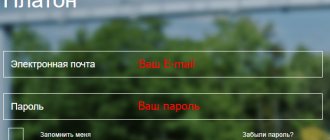Are all vehicles with a maximum permissible weight of 12 tons required to participate in the PLATO compulsory collection system for future costs of repairing the damage they cause?
The question is very interesting and relevant. After all, if, for example, the passport data indicates the maximum permissible weight of the entire car together with the body and trailer, but during a specific period the car moves, as they say, lightly with one cab for the driver, is it necessary to pay for its movement on federal highways?
Let's turn to the Law and see what is written in it.
What is “Plato”
“Platon” is a system for collecting tolls on federal roads (official website).
Not all vehicles are subject to taxation, but only heavy trucks with a permissible maximum weight of more than 12 tons.
Federal roads (or otherwise, federal roads) should be understood as transport routes connecting:
- Moscow with the capitals of the republics (regions) and the most important cultural and industrial centers of Russia;
- republican and administrative centers of territories and regions;
- the same federal centers with airports, railway stations and stations, ports on rivers and seas;
- objects of federal significance, incl. nature reserves, resorts, scientific centers, historical and cultural monuments, etc.
The main purpose of the funds received through Platon is to compensate for the damage caused to roads by heavy vehicles. Using revenues, they ensure the maintenance of good condition of highways, finance construction and repair work and develop road and transport infrastructure.
Background
The more cars travel on the roads of our Motherland, the more their surface wears out, and the more often repairs are required.
The main damage is believed to be caused by large-capacity trucks, which not only wear out the asphalt surface, but also push through the “cushion” of sand, crushed stone and special materials, which causes rutting and increased accident rates on the roads.
All roads in our country have either federal or regional subordination . If in the regions a transport tax is collected for repairs, then roads, for the condition of which the state is responsible, are built and maintained at the expense of the state budget. And with the increase in cargo traffic, the allocated funds became insufficient.
That is why, on behalf of the Government of the Russian Federation, the “Platon” system for paying for travel on federal highways was developed and implemented. Its name comes from the words “pay” and “ton” .
The essence of “Platon” is that with the help of satellite monitoring equipment, the route of movement of the car is tracked, the data is entered into the system, the mileage traveled is calculated, and the funds are debited from the account assigned to this car.
Thus, the state budget receives financial injections daily, directing them to the maintenance of the system, to the income of investors and to repair roads.
It should be noted that tolls on state roads for freight and cargo-passenger transport are already in effect in almost all European countries.
This idea was first implemented in Austria - since 2004, highways there have been equipped with appropriate equipment and a tariff system has been in place.
In Russia, the truck toll system was introduced only on November 15, 205, but long before this date, truck drivers and owners of trucks and heavy trucks began to protest.
Video: How the Plato system works
Laws on the “Plato” payment system
The starting point for launching the entire toll collection system was the Law “On Amendments to the Legislation of the Russian Federation” dated April 6, 2011 No. 68-FZ. This document changed the articles and norms:
- Federal Law dated November 8, 2007 No. 257-FZ “On Highways”.
- Budget Code of the Russian Federation (approved by the Federal Law of July 31, 1998 No. 145-FZ).
- Code of Administrative Offenses of the Russian Federation (adopted by the State Duma on December 20, 2001).
The final chord was the Decree of the Government of the Russian Federation dated June 14, 2013 No. 504 “On charging fees to compensate for damage caused to roads.”
By the time Resolution No. 504 was issued, the main parameters of the new system had already been formed:
- the “Platon” collection system is tied directly to the moving vehicle: with the help of special procedures and means of accounting and control, the entire route of the heavy load is recorded in “Platon”. And that part of it that runs along federal highways is subject to payment. In this case, neither the ownership of the car nor even the country of its registration matters (foreigners pay the same as Russians);
- Payment collection at Plato is carried out by a specially appointed operator. He transfers the collected funds to the budget and also receives remuneration for his activities;
The Platon toll collection system for the budget is controlled by a private operator, RT-Invest Vehicles LLC.
- There are several ways to control the movement of heavy trucks. If an unpaid truck with a suitable tonnage is detected by control means on a federal road, information about this is sent to the traffic police, which imposes a fine in accordance with Art. 12.21.3 Code of Administrative Offenses of the Russian Federation.
Amount of fines
At the very beginning there was a proposal to punish legal entities with a fine of up to 1 million rubles. But drivers began to protest, and the amounts were changed; their amount and collection procedure are specified in the Administrative Code.
- For the first violation - 5 thousand rubles (the driver is a private individual, a citizen of Russia).
- The first violation of a legal entity in Russia – 5,000 rubles.
- Primary violation for foreign cars – 5,000 rubles.
- Secondary violation by a citizen of the Russian Federation, a private person - 10 thousand rubles.
- Second violation of a legal entity in Russia – 10 thousand rubles.
- Repeated violation for foreign cars – 10,000 rubles (payment must be made by the driver).
Which cars fall under the Plato system?
Tolls were introduced for those cars that cause the greatest damage to roads:
Important
Traffic police inspectors can identify vehicles with a permissible weight of up to 12 tons, but loaded in excess of this. The traffic police is given the right to check the weight of questionable vehicles. If an excess is detected, the fine will be exactly the same as for driving a truck with a permissible weight of more than 12 tons without registration in Plato.
In conclusion, we will consider which cars are definitely not eligible for payment at Plato. So. it does not apply to:
- vehicles intended for passenger transportation;
- military equipment of the Ministry of Defense of the Russian Federation;
- cars;
- trucks up to 12 tons.
How to calculate the total weight of a car for travel using the PLATO system?
To find out for yourself whether you need mandatory registration in the system with further payment, carefully study the documentation for your vehicle:
- pay attention to the line with the permissible or permitted weight of your car;
- the weight of the cargo being transported and the specific gravity of the car itself;
- weight of the car including a full tank of fuel and lubricants;
- the presence of a trailer and other types of additional means of transportation (cars with a rigid hitch).
After analyzing these numbers, we can conclude whether you and your car are required to register in the system or not.
If you have any doubts, you can ask any question you are interested in and get an answer online.
Payment for roads through Plato
Calculations through “Plato” can be described in a few simple steps.
Step 1. We determine that the car that will go on the road falls under “Plato”. This is easy to do by using our diagram and looking at the PTS.
Step 2. Register the vehicle and owner in the system. This can be done in several ways:
- through the personal account of the Plato charging system ( for information on how to do this, read the article “Plato: registration rules” );
- through a self-service terminal;
- in the User Support Center.
Step 3. Make a prepayment for the trip to the registered personal account in the system (currently, for those who have already been registered in the system for quite some time and pay without violations, there are postpaid payment options. You can find out more about them in a special section on the Platon website );
Step 4. Enter the planned route of the vehicle into the “Platon” service (issue a route map ) or equip the truck with the “Platon” on-board device, which will transmit information about the route to the system.
Important
On-board devices of the Platon toll collection system are provided and installed free of charge.
At this point, the main actions of the owner of the vehicle can be considered completed. Further calculation of the payment and transfer of its amount to the budget will be performed by the operator. Based on calculations and payments made, the payer can receive reports through LC “Platon”. These reports can be used as supporting documents to offset fees in “Platon” in reducing transport tax in the Federal Tax Service.
Out on the track
By government order dated August 29, 2014, RTITS became the concessionaire. 50% of RTITS belongs to Igor Rotenberg, 50% to RT-Invest, an investment company of the Rostec state corporation. The system was launched on November 15, 2015. In the first four months of operation, Platon collected about 4.8 billion rubles for the Russian road fund, and 665 thousand vehicles belonging to 225 thousand owners were registered in the system.
At the first stage of work on the system (2013–2014), Rosavtodor planned to hold a competition and even began collecting applications - in 2014, among the participants were, for example, the French company Vinci, the Italian Autostrade, the German Siemens and the Slovak SkyToll. As representatives of Rosavtodor explained, it was decided to abandon the competition due to “a change in the geopolitical situation” and “national security considerations.”
Tariffs “Platon”: latest news
Since the introduction of this toll system, tariffs for travel on federal roads have already been revised several times.
Read about changes in Plato rates in 2022 and the coming 2021 in the article: “New tariffs of the Plato system in 2022.”
Let us remind you that knowledge of the tariff is usually necessary with a prepaid payment system, since an amount sufficient to be debited for the route must be deposited into your personal account in full.
Let us also remind you that there are a large number of payment methods at Plato:
| PAYMENT FOR “PLATON” ROUTE CARD | REPLENISHING YOUR ACCOUNT RECORD “PLATON” |
|
|
Calculation rules
If we recall previous years, there was a lot of talk around the “Platon” system, or rather the tariff system, which was accompanied by numerous strikes throughout the country.
Initially, the Government of the Russian Federation planned to charge truck owners 3.73 rubles for each kilometer of travel. Mass protests by truckers swept across the country and the tariff was reduced to 1.53 rubles. per kilometer. It remained at this rate until April 2022, after which it was increased, and the cost of a kilometer traveled began to be 1.90 rubles. This tariff is also valid at the beginning of 2022, but there are persistent rumors that the amount will be indexed to the inflation rate from July 1, 2022. According to Rosstat, inflation for 2022 is 4.3%
Is it possible to evade paying?
There are several legal options for getting out of this situation:
- If the driver knows the bypass routes and routes, then he does not have to use large transport arteries; he will be able to travel to his destination both on a narrow-gauge railway and on a road with crushed stone pavement absolutely free.
- Or use a completely legal toll road, then PLATO is not afraid of him, and he will not have to pay the same thing twice.
- Change to a vehicle with a lower permissible weight. And if this amount of expenses is significant, then you can choose this option for your activities in order to reduce your travel costs.








